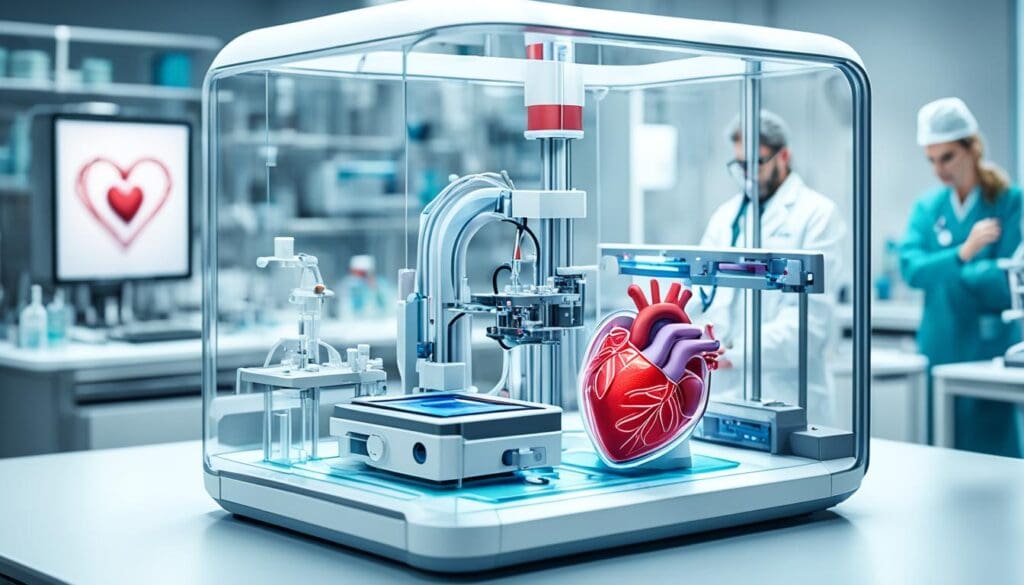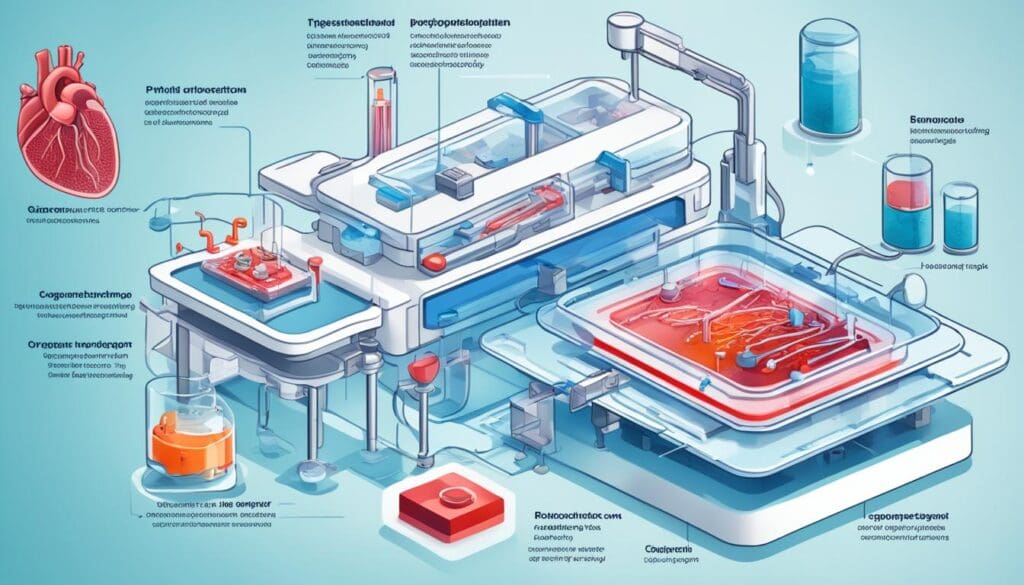Every 10 minutes, someone new needs an organ transplant in the United States. This shows we need new ways to help. 106,800 people are waiting for organs by March 2023.
3D bioprinting is a new way to make organs. It uses the patient’s cells to avoid rejection. This method could end the need for pills that lower your immune system.
It might take ten years before we see 3D-printed organs used in people. But, science is getting closer every day.

Xenotransplantation is the use of animal organs in humans. In 2022, a man got a heart from a pig and lived two months. Companies like United Therapeutics are working on this. They are making pigs with organs that people can use.
These new ways to make organs offer hope to millions. We might soon live in a world without organ shortages.
Key Takeaways
- Over 106,800 people are on the US organ transplant waiting list
- A new person is added to the waiting list every 10 minutes
- 3D bioprinting could create custom organs using patient’s own cells
- Xenotransplantation trials with pig organs are set to begin in 2024
- These technologies could potentially eliminate organ shortages
- Biotech companies are leading the charge in developing these innovative solutions
The Organ Shortage Crisis: A Global Challenge
The shortage of organs is a big problem that touches lives all over the world. The United States is among the places where waiting lists for transplants are getting longer each year. This mirrors a trend seen globally, where more and more people need organs.
Current statistics on organ transplant waiting lists
By 2023, more than 106,000 Americans need a new organ to survive. Sadly, about 17 of them pass away daily while waiting. In 2022, just 41,356 transplants took place. This huge gap between the number of people needing organs and those who get them is a major issue.
| Organ | Waiting List | Transplants Performed (2022) |
|---|---|---|
| Kidney | 90% | 25,498 |
| Liver | 10% | 9,263 |
| Heart | 3% | 3,747 |
| Lung | 2% | 2,524 |
Limitations of traditional organ donation methods
Old ways of donating organs have their own set of problems. Matching the right donor with the recipient, ensuring the organ’s quality, and getting it to the right place on time are all hurdles. For those with kidney problems, dialysis can help but comes with a high cost to life and health.
The urgent need for innovative solutions
We must find new solutions to the organ shortage crisis. Technologies such as 3D printing of tissues and organs and using organs from animals, known as xenotransplantation, show great promise. If successful, these new methods could mean more transplants and fewer lives lost waiting.
The field of organ transplantation needs to change radically. By using the latest tech and bringing researchers and companies together, we can imagine a world with no waiting for organ transplants.
Understanding 3D Bioprinting Technology
3D bioprinting changes how we see organ transplants. This high-tech method fights the shortage of organs worldwide. It uses cells from the patient and safe materials to make organs that act and look like the real ones.
The Science Behind 3D Organ Bioprinting
First, a small piece of the patient’s tissue is taken out. Cells are then grown from this in a lab. These cells are mixed with special materials, called bioinks. These materials help the cells grow the right way to form organs.
Key Components: Bioinks, Scaffolds, and Cell Sources
Bioinks are key in 3D printing organs. They give structure and help the cells. Scaffolds, made of natural materials, support the growth of the cells. When printing different organs, the choice of cells varies. Stem cells are a popular choice because they can become many types of cells.
| Component | Function | Examples |
|---|---|---|
| Bioinks | Provide structure and support | Hydrogels, growth factors |
| Scaffolds | Framework for tissue growth | Collagen, gelatin |
| Cell Sources | Building blocks of printed organs | Stem cells, organ-specific cells |
Advantages of 3D-Printed Organs
3D-printed organs have big benefits over old transplants. They can match the patient perfectly, lowering rejection risks. Making organs when needed could cut the wait for transplants. Even though fully working 3D organs are a way off, this tech offers hope for getting more organs and helping patients better.
Xenotransplantation: A Promising Alternative
Xenotransplantation is the act of moving organs from one type of animal to another. It’s becoming a great way to deal with not having enough organs. With the help of genetic engineering, we can now look to pigs as organ donors. This brings new hope to many who need organ transplants to survive.
There have been big steps forward in xenotransplantation lately. For example, in March 2024, a man got a pig’s kidney and was well enough to go home just two weeks after. And back in 2022, someone had a pig’s heart put in and lived for two months after.
Groups like United Therapeutics, eGenesis, and Makana Therapeutics are leading the charge. They are working on gene-edited pigs for organ donation. The goal is to make the organs more alike to humans, so they work better together.
“Xenotransplantation could revolutionize the field of organ transplantation, potentially saving thousands of lives each year.”
But, there are still big challenges to face. One is the body rejecting the new organ. Another is the chance of sickness passing between animals and people. The FDA wants to see six months of animals using these organs living and being healthy. Plus, they ask for pigs to grow up without getting any germs. When these conditions are met, human tests can start, likely starting in 2024.
As we move forward with xenotransplantation, it’s a bright spot for those over 103,800 on the U.S. waiting list. This new method could cut the wait and save lives. It might change organ transplants as we know them, for the better.
Breakthrough technologies in organ transplantation
Advanced organ transplantation methods are giving hope to many. With the help of 3D printing and genetic tweaks, doctors are getting better at replacing organs. This is critical given the lack of donor organs.
Recent advancements in 3D bioprinting techniques
3D bioprinting is becoming more sophisticated. It can now make complex organ parts. This is all thanks to better printing materials and machines.
Researchers have even printed small organs with working blood vessels. This achievement is a big step toward full organ printing. Imagine printing hearts or kidneys one day!

Progress in genetic engineering for xenotransplantation
Genetic editing is also changing the game for xenotransplantation. With techniques like CRISPR, we can adjust pig genes to make their organs better fit for humans. A major breakthrough was seen in 2022 with a pig heart successfully replacing a human one.
Combining technologies for optimal results
Scientists are considering how to mix 3D bioprinting with gene editing. The vision is to craft organs that are both strong and won’t be readily rejected by the body. This could be done by seeding 3D-printed structures with pig cells adjusted by gene editing.
| Technology | Key Advancement | Potential Impact |
|---|---|---|
| 3D Bioprinting | Vascularized tissue printing | Creation of complex, functional organs |
| Genetic Engineering | CRISPR-modified pig organs | Reduced immune rejection in xenotransplantation |
| Combined Approach | 3D-printed scaffolds with modified cells | Customized, compatible organ production |
All these developments bring a ray of hope to the 104,000 Americans waiting for new organs. But, it’s through everyone’s combined effort that we can make real change. Collaboration will one day end the era of organ shortages and uplift the lives of those needing transplants.
Challenges and Limitations in Organ Bioengineering
Advancements in bioengineering organs face significant hurdles. These include technical, ethical, and regulatory challenges before safe application in patients.
Technical Hurdles in Creating Fully Functional Organs
Replicating natural organs poses big technical challenges. Scientists find it hard to create the detailed structures of hearts or livers.
Ethical Considerations and Regulatory Obstacles
Organ bioengineering ethical challenges involve animal welfare and fair tech access. Rules like FDA trials and safety checks also slow progress.
Addressing Immune Rejection and Compatibility Issues
Overcoming immune rejection is key in transplants. Techniques to lower host immune reactions and better match organs are being developed.
| Year | Milestone | Significance |
|---|---|---|
| 2004 | First human transplantation of bioengineered airway tissue | Pioneered the use of bioengineered tissues in humans |
| 2006 | Development of human tissue-engineered blood vessels | Opened possibilities for vascular repair and replacement |
| 2008 | Perfusion-decellularized matrix used for bioartificial hearts | Demonstrated potential for whole organ bioengineering |
| 2022 | Heart xenotransplant using gene-edited pig | Marked significant progress in xenotransplantation |
Although progress is visible, bioengineered organs require more work. Research, funding, and teamwork are crucial. The goal is to make bioengineered organs widely available to save lives.
The Role of Stem Cells in Organ Regeneration
Stem cells are vital in fixing organs and creating new tissues. They hold a key to changing how we do organ transplants. With new findings in stem cell research, we’re exploring fresh ways to make organs work and cure illnesses.

Experts are getting better at using stem cells to regenerate organs. They’ve made working kidneys and mammary glands from these cells. This discovery is great news for those needing transplants.
Stem cell therapy has also shown real hope in healing. A child with a severe bone condition got stem cells from fetal sources. This treatment helped them grow new bone. It’s a big step in fighting bone diseases with stem cells.
“Stem cell therapy uses cells instead of donor organs for transplantation, offering a revolutionary approach to organ regeneration.”
Improvements in making organs outside the body are being made too. There are now special machines that help fix kidney and liver structures. These new tools could lead us to build even more intricate organs in the future.
The dream of using stem cells to make organs isn’t easy, though. We still need to figure out how to get the right cells and do it safely. But, the progress we’re making is promising. As we keep learning, the hope is to make organ waits shorter and health better for everyone.
Future Prospects: Personalized Organ Manufacturing
The future of organ transplantation is looking up, thanks to personalized organ manufacturing. This new approach aims to solve problems like the shortage of donor organs. It also wants to cut down the long lists of people waiting for transplants.
Tailoring Organs to Individual Patient Needs
Imagine getting a new organ that’s made just for you. With personalized organs, that’s becoming a real possibility. Doctors use your cells to craft organs that fit your unique genetic code. This makes rejection less likely and increases the success of the transplant.
Potential for On-Demand Organ Production
What if we could make organs whenever we need them? This dream’s not far off. With on-demand organ production, we could avoid wait times and keep more people alive. The global bioprinting market is growing fast, showing how much need there is for this life-saving technology.
Impact on Organ Transplant Waiting Lists and Healthcare Costs
Personalized organs could cut down waiting lists by a lot. In just the United States, over 110,000 people wait for new organs, and 20 people die each day due to the wait. Although getting this tech started costs money, it could save a lot in the long run compared to current transplant costs.
| Aspect | Current Situation | Future with Personalized Organs |
|---|---|---|
| Waiting List | 110,000+ in the U.S. | Potentially eliminated |
| Organ Lifespan | 10-20 years | Potentially longer |
| Rejection Risk | High | Significantly reduced |
| Healthcare Costs | High long-term costs | Potential long-term savings |
As we move forward with this technology, the future of organ transplantation looks bright. It will bring hope to many who suffer from organ failure. And in the long run, it could even save money for healthcare systems around the world.
Collaborative Efforts: Research Institutions and Industry Partnerships
The world of organ transplantation is now filled with new partnerships and research. More than 100,000 people wait for a transplant, making these team efforts vital. The OPTN Modernization Initiative speeds up how organs are donated and moved for transplant.
Working with companies speeds up new medical tech. The DRI Cell Transplant Center’s Fast Track Center tests new diabetes tech. One exciting project pairs stem cells with special cells to help treat Type 1 diabetes. iTolerance, Inc. and Kadimastem, Ltd. both helped make this happen.
Even the government is helping push forward. The HRSA is making a new board for the OPTN to watch over things better. They aim for better results by focusing more and increasing responsibility. They want to make kidney transplants fairer, showing how important equal chances are in these partnerships.
FAQ
What is the current state of the organ shortage crisis?
As of March 2023, about 106,800 people in the US need organs. Only 14,000 get transplants from living or deceased people each year. Sadly, 17 people die daily as they wait for a new organ.
How does 3D bioprinting work for creating artificial organs?
3D bioprinting works by putting together a patient’s cells and special materials. First, doctors take a small part of the patient’s tissue. This is called a biopsy.
The cells get mixed with special inks. Then, a bioprinter prints them layer by layer. The printer builds the structure using these cells and materials.
What are the advantages of xenotransplantation?
Xenotransplantation means using organs from different species. It allows for more organs available for transplant. Researchers are using pigs, successfully transplanting their kidneys and hearts into humans.
What are some recent advancements in organ bioengineering technologies?
Advances like better inks and more detailed printers help 3D bioprinting. Also, techniques like CRISPR help change pig genes. This makes pig organs safer for human bodies to use.
What are the potential benefits of personalized organ manufacturing?
Making organs from a patient’s cells can make transplants safer and quicker. It also aims to help more people get the organs they need. This method may greatly improve life for those with organ issues.
What role do stem cells play in organ regeneration and tissue engineering?
Stem cells are key in fixing organs and tissues. They help grow small organs called organoids. They can also fix larger organs and improve 3D printing technology as a cell source.
What are some key challenges and limitations in organ bioengineering?
Organizing blood vessels in new organs is tough. Also, making these organs work like real ones is a big challenge. Using animals raises ethical questions and must be fair for all. Plus, making sure new treatments are safe is tricky.
Source Links
- https://www.technologyreview.com/2023/01/11/1064800/martine-rothblatt-transplantable-organs-10-breakthrough-technologies-2023/ – The entrepreneur dreaming of a factory of unlimited organs
- https://www.cnn.com/2022/06/10/health/3d-printed-organs-bioprinting-life-itself-wellness-scn/index.html – When we’ll be able to 3D-print organs and who will be able to afford them | CNN
- https://www.ncbi.nlm.nih.gov/pmc/articles/PMC6861853/ – THE POTENTIAL ROLE OF 3D-BIOPRINTING IN XENOTRANSPLANTATION
- https://www.ncbi.nlm.nih.gov/pmc/articles/PMC3678939/ – Challenges in Organ Transplantation
- https://www.pghr.org/post/tackling-the-organ-shortage-crisis – Tackling the Organ Shortage Crisis
- https://www.sir.advancedleadership.harvard.edu/articles/engineering-high-tech-solutions-organ-shortage – The Long Haul: Engineering High-Tech Solutions to the Organ Shortage — Harvard ALI Social Impact Review
- https://www.ncbi.nlm.nih.gov/pmc/articles/PMC8252697/ – 3D Printing: Advancement in Biogenerative Engineering to Combat Shortage of Organs and Bioapplicable Materials
- https://www.news-medical.net/health/Bioprinting-Organs-A-Look-into-the-Future-of-Transplantation.aspx – Bioprinting Organs: A Look into the Future of Transplantation
- https://www.ncbi.nlm.nih.gov/pmc/articles/PMC7728666/ – 3D Bioprinting and the Future of Surgery
- https://www.nature.com/articles/s43856-024-00511-0 – Xenotransplantation could either be a friend or foe of healthcare equity – Communications Medicine
- https://www.ncbi.nlm.nih.gov/pmc/articles/PMC6462010/ – Emerging approaches and technologies in transplantation: the potential game changers
- https://www.ncbi.nlm.nih.gov/pmc/articles/PMC9230910/ – Evolution of Xenotransplantation as an Alternative to Shortage of Donors in Heart Transplantation
- https://newsnetwork.mayoclinic.org/discussion/mayo-clinic-expert-3-advances-lead-to-more-lifesaving-organ-transplants/ – Mayo Clinic expert: 3 advances lead to more lifesaving organ transplants – Mayo Clinic News Network
- https://www.facs.org/for-medical-professionals/news-publications/news-and-articles/bulletin/2024/april-2024-volume-109-issue-4/new-technologies-approaches-help-surgeons-maximize-the-use-of-transplant-organs/ – New Technologies, Approaches Help Surgeons Maximize the Use of Transplant Organs
- https://www.ncbi.nlm.nih.gov/pmc/articles/PMC4911019/ – New and old technologies for organ replacement
- https://www.ncbi.nlm.nih.gov/pmc/articles/PMC4825836/ – Bioengineering for Organ Transplantation: Progress and Challenges
- https://www.ncbi.nlm.nih.gov/pmc/articles/PMC1350600/ – The immunologic barriers to replacing damaged organs
- https://www.frontiersin.org/articles/10.3389/frtra.2022.897679 – Frontiers | Grand Challenges in Organ Transplantation
- https://www.ncbi.nlm.nih.gov/pmc/articles/PMC9973391/ – Organ Regeneration Through Stem Cells and Tissue Engineering
- https://www.ncbi.nlm.nih.gov/pmc/articles/PMC4517320/ – Applications of regenerative medicine in organ transplantation
- https://www.mayoclinic.org/tests-procedures/bone-marrow-transplant/in-depth/stem-cells/art-20048117 – Answers to your questions about stem cell research
- https://www.ncbi.nlm.nih.gov/pmc/articles/PMC10212693/ – Building the future of synthetic organ manufacturing and healthcare
- https://www.medicaldevice-network.com/analyst-comment/3d-printing-human-organs/ – Revolutionising healthcare: bioprinting takes a leap forward in 2024
- https://arpa-h.gov/research-and-funding/programs/print – PRINT
- https://www.hrsa.gov/optn-modernization – Organ Procurement and Transplantation Network (OPTN) Modernization Initiative
- https://news.med.miami.edu/diabetes-research-institute-announces-transplantation-for-type-1-diabetes/ – Diabetes Research Institute Announces Breakthrough Transplantation Approach for the Treatment of Type 1 Diabetes at ADA 2024 – InventUM
- https://www.hhs.gov/about/news/2024/05/08/biden-harris-administration-acts-improve-access-kidney-transplants.html – Biden-Harris Administration Acts to Improve Access to Kidney Transplants